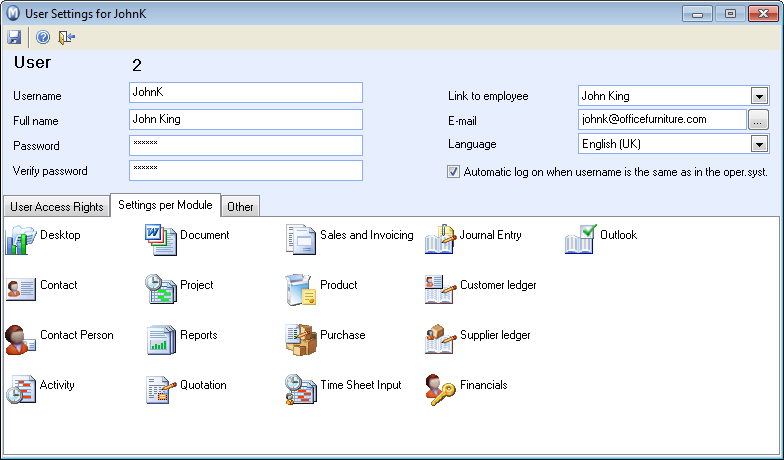User Settings
View - Settings - User or View - Settings - Security - User
Administration ![]()
Everyone working in the program should have their own user profile in the User settings. The User Settings need to be created by a user with system administrator or super user status, via the View - Settings - Security - User administration. However, later on the individual user can adjust their own settings if their access rights permit this. The access rights are determined by the original settings made by the system administrator or super user.
![]() The user can open the user settings from the toolbar within the individual
modules. The user settings can also be accessed via View
- Settings - User.
The user can open the user settings from the toolbar within the individual
modules. The user settings can also be accessed via View
- Settings - User.

Who is the administrator?
The system requires that at least one user is set up with full access/super user status. Full access/super user is a separate option, but if you are to set up a user with system administrator status you also assign that user certain access rights. The difference is that a Super user has access to everything, whereas the system administrator has access to functions that naturally belong to the work processes associated with system administrator tasks. A user whose access profile includes Full access/Super user is usually the same person who has the ultimate administrative responsibility within the system.
User name and password
Under User administration you enter the employee's User name and Password that are used when logging in to the program. The Password must be entered both into the Password field and the Confirm Password field. This is to ensure that the password is correct. Read more in User name and Password.
Link to employee
You can link a user to an employee from the Employee Register. If the user is not created as an employee, you can create a new employee when saving the user details. Read more in Linking a User to an Employee.
This is where you enter your e-mail address. This address will later be the sender's address for all your e-mails sent from the program.
![]() If you have Microsoft Outlook installed on your computer, you can click
on the search button to retrieve your e-mail address from your user account
there. The program can also be synchronised with Outlook. Read more in E-mail in the Program.
If you have Microsoft Outlook installed on your computer, you can click
on the search button to retrieve your e-mail address from your user account
there. The program can also be synchronised with Outlook. Read more in E-mail in the Program.
Language
Every user can use the program in his or her Language, if the desired language is available. Note that the program must be restarted before the settings take effect.
Automatic log on when user name is the same as in operating system:
Select this optionif your Mamut user name is the same as your user name for logging in to Windows. This way you avoid having to log into Mamut Business Software upon starting the program.
User Access Rights
The function for assigning user access rights in Mamut Business Software has been developed bearing in mind that several users are working with the same system. With the help of the user access rights, the system administrator can ensure that the various users do not have access to all components of the system, but only those functions they need in order to complete their work.
Settings per Module (User Settings)
![]() The Settings
per Module tab gathers the User settings for every single module.
All settings entered into the user profile apply to the current user only.
The settings can be made by the user him/herself or by the system administrator.
The Settings
per Module tab gathers the User settings for every single module.
All settings entered into the user profile apply to the current user only.
The settings can be made by the user him/herself or by the system administrator.
Services
Under the Services tab you can activate and deactivate the mobile user from the Visma Mobile Scanner service. Read more about this service About the Mobile Scanner app.
Other
Under the Other tab you can enter several more settings which may help to simplify the startup and usage of your program.
Read more about:
Automatically open a Window at Login
User Settings, User Access Rights